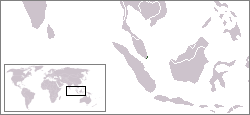
Singapore

Singapore (Chinese: 新加坡; pinyin: Xīnjiāpō; Malay: Singapura; Tamil: சிங்கப்பூர், Cingkappūr), officially the Republic of Singapore, is an island microstate located at the southern tip of the Malay Peninsula. It lies 137 kilometres (85 mi) north of the equator, south of the Malaysian state of Johor and north of Indonesia's Riau Islands. At 707.1 km2 (273.0 sq mi),[4] Singapore is one of four remaining true city-states in the world. It is the smallest nation in Southeast Asia.
Before European settlement, the island now known as Singapore was the site of a Malay fishing village at the mouth of the Singapore River. Several hundred indigenous Orang Laut people also lived along the nearby coast, rivers and on smaller islands. In 1819 the British East India Company established a trading post on the island, which was used thereafter as a strategic trading post along the spice route.[5] Singapore would become one of the most important commercial and military centres of the British Empire, and the hub of British power in Southeast Asia. The city was occupied by the Japanese during World War II, which Winston Churchill called "Britain's greatest defeat".[6] Singapore reverted to British rule immediately after the war, in 1945. Eighteen years later the city, having achieved independence from Britain, merged with Malaya, Sabah and Sarawak to form Malaysia. However, less than two years later it seceded from the federation and became an independent republic on 9 August 1965. Singapore joined the United Nations on 21 September that same year. It is also a member of the Commonwealth of Nations.
Since independence, Singapore's standard of living has been on the rise. Foreign direct investment and a state-led drive to industrialisation based on plans drawn up by the Dutch economist Albert Winsemius have created a modern economy focused on industry, education and urban planning.[7] Singapore is the 5th wealthiest country in the world in terms of GDP (PPP) per capita.[8] This small nation has foreign exchange reserves of more than US$177 billion.[9]
The population of Singapore is approximately 4.84 million.[2] Singapore is highly cosmopolitan and diverse with Chinese people forming an ethnic majority with large populations of Malay, Indian and other people. English, Malay, Tamil, and Chinese are the official languages.[10]
The Constitution of the Republic of Singapore established the nation's political system as a representative democracy, while the country is recognised as a parliamentary republic.[11] The People's Action Party (PAP) dominates the political process and has won control of Parliament in every election since self-government in 1959.[12]



Good information of singapore
ReplyDelete